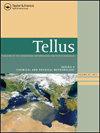Net CO2 exchange rates in three different successional stages of the
IF 4.3
4区 地球科学
Q3 METEOROLOGY & ATMOSPHERIC SCIENCES
Tellus Series B-Chemical and Physical Meteorology
Pub Date : 2002-11-01
DOI:10.1034/J.1600-0889.2002.01351.X
引用次数: 56
Abstract
The net ecosystem exchange (NEE) of successional stages of the Abies -dominated dark taiga was measured in central Siberia (61°N 90°E) during the growing season of the year 2000 using the eddy covariance technique. Measurements started before snow melt and canopy activity in spring on day of year (DOY) 99 and lasted until a permanent snow cover had developed and respiration had ceased in autumn DOY 299. Three stands growing in close vicinity were investigated: 50 yr-old Betula pubescens (“Betula stand”, an early successional stage after fire), 250 yr-old mixed boreal forest, representing the transition from Betula -dominated to Abies -dominated canopies, and 200-yr-old Abies sibirica (“Abies stand”, representing a late successional stage following the mixed boreal forest). The mixed boreal forest had a multi-layered canopy with dense understory and trees of variable height and age below the main canopy, which was dominated by Abies sibirica , Picea obovata and few old Betula pubescens and Populus tremula trees. The Abies stand had a uniform canopy dominated by Abies sibirica . This stand appears to have established not after fire but after wind break or insect damage in a later successional stage. The stands differed with respect to the number of days with net CO 2 uptake (Betula stand 89 days, mixed boreal forest 109 days, and Abies stand 135 days), maximum measured LAI (Betula 2.6 m 2 m −2 , mixed boreal forest 3.5 m 2 m −2 and Abies stand 4.1 m 2 m −2 ) and basal area (Betula stand 30.2 m 2 ha −1 , mixed boreal forest 35.7 m 2 ha −1 , and Abies stand 46.5 m 2 ha −1 ). In the mixed boreal forest, many days with net daytime CO 2 release were observed in summer. Both other sites were almost permanent sinks in summer. Mean daytime CO 2 exchange rates in July were −8.45 μmol m −2 s −1 in the Betula stand, −4.65 μmol m −2 s −1 in the mixed boreal forest and −6.31 μmol m −2 s −1 in the Abies stand. Measured uptake for the growing season was −247.2 g C m −2 in the Betula stand, −99.7 g C m −2 in the mixed boreal forest and −269.9 g C m −2 in the Abies stand. The total annual carbon uptake might be slightly lower (i.e. less negative) due to some soil respiration under snow in winter. The study for the first time demonstrates that old forests in the “Dark Taiga” are carbon sinks and that sink activity is very similar in late and early successional stages. Canopy and crown structure with associated self-shading and available radiation are suggested as possible causes for the observed differences. DOI: 10.1034/j.1600-0889.2002.01351.x三个不同连续阶段的二氧化碳净交换率
利用涡动相关方差技术测定了西伯利亚中部(61°N - 90°E)冷杉为主的暗针叶林在2000年生长期演替阶段的净生态系统交换(NEE)。测量开始于99年春季积雪融化和冠层活动之前,一直持续到299年秋季永久积雪形成和呼吸停止。研究了近距离生长的3个林分:50年树龄的短毛桦林(“桦林”,火灾后演替的早期阶段)、250年树龄的北方混交林,代表了从桦树为主向冷杉为主的林冠过渡,以及200年树龄的西伯利亚冷杉林(“冷杉林”,代表了北方混交林后演替的后期阶段)。混交林林冠层多,林下灌木茂密,主冠层以下乔木高度和树龄均有变化,以西伯利亚冷杉、倒云杉为主,少数老白桦和白杨。冷杉林冠层均匀,以西伯利亚冷杉为主。这种林分似乎不是在火灾之后建立起来的,而是在后期演替阶段的风折或虫害破坏之后建立起来的。看台上对不同的天数与净CO 2吸收(桦木属站89天,北方森林109天,混合和冷杉属站135天),最大测量赖(桦木属2.6米2 m−2,混合北方森林3.5 2 m−−2和冷杉属站4.1米2米2)和基底面积(桦木属站30.2米2公顷−1,混合北方森林35.7 2公顷−1,和冷杉属站46.5米2公顷−1)。在北方混交林中,夏季有许多白天净co2释放日。另外两个地点在夏季几乎都是永久的碳汇。7月白桦林分白天CO 2平均交换速率为−8.45 μmol m−2 s−1,混交林为−4.65 μmol m−2 s−1,冷杉林分为−6.31 μmol m−2 s−1。桦木林分的生长季碳吸收量为- 247.2 g cm - 2,北方混交林为- 99.7 g cm - 2,冷杉林分为- 269.9 g cm - 2。由于冬季积雪下的土壤呼吸作用,年总碳吸收量可能略低(即负碳量较小)。该研究首次证明了“暗针叶林”的原始森林是碳汇,并且碳汇活动在演替后期和早期非常相似。树冠和树冠的自遮阳结构和有效辐射被认为是造成观测差异的可能原因。DOI: 10.1034 / j.1600-0889.2002.01351.x
本文章由计算机程序翻译,如有差异,请以英文原文为准。
求助全文
约1分钟内获得全文
求助全文
来源期刊
自引率
0.00%
发文量
3
期刊介绍:
Tellus B: Chemical and Physical Meteorology along with its sister journal Tellus A: Dynamic Meteorology and Oceanography, are the international, peer-reviewed journals of the International Meteorological Institute in Stockholm, an independent non-for-profit body integrated into the Department of Meteorology at the Faculty of Sciences of Stockholm University, Sweden. Aiming to promote the exchange of knowledge about meteorology from across a range of scientific sub-disciplines, the two journals serve an international community of researchers, policy makers, managers, media and the general public.

 求助内容:
求助内容: 应助结果提醒方式:
应助结果提醒方式:


